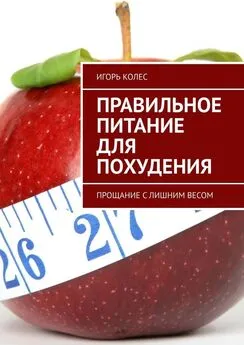Шарлотта Марки - Умным диеты не нужны. Последние научные открытия в области борьбы с лишним весом
- Название:Умным диеты не нужны. Последние научные открытия в области борьбы с лишним весом
- Автор:
- Жанр:
- Издательство:Array Литагент «Альпина»
- Год:2015
- Город:Москва
- ISBN:978-5-9614-3928-1
- Рейтинг:
- Избранное:Добавить в избранное
-
Отзывы:
-
Ваша оценка:
Шарлотта Марки - Умным диеты не нужны. Последние научные открытия в области борьбы с лишним весом краткое содержание
Умным диеты не нужны. Последние научные открытия в области борьбы с лишним весом - читать онлайн бесплатно ознакомительный отрывок
Интервал:
Закладка:
Stunkard, A. J., & Rush, J. (1974). Dieting and depression reexamined: Acritical review of reports of untoward responses during weight reduction for obesity.Annals of Internal Medicine, 81, 526–533.
17
Ogden, J. (1992). Fat Chance! The Myth of Dieting Explained. Routledge: NewYork.
18
Wegner, D. M., Schneider, D. J., Carter, S., & White, T. (1987). Paradoxical effects of thought suppression. Journal of Personality and Social Psychology, 53, 5–13.
19
Polivy, J., & Herman, C. P. (2002). If at first you don’t succeed: False hopes of self change. American Psychologist, 9, 677–689.
20
Ibid.
21
McFarlane, T., Polivy, J., & Herman, C. P. (1998). Effects of false weight feedback on mood, self-evaluation, and food intake in restrained and unrestrained eaters.Journal of Abnormal Psychology, 107, 312–318.
22
McFarlane, T., Polivy, J., McCabe, R. E. (1999). Help not harm: Psychological foundation for a nondieting approach toward health. Journal of Social Issues, 55, 261–276.
23
Polivy & Herman (2002).
24
Ibid.
25
U.S. Weight Loss Market Worth $60.9 Billion. (2011, May 9). PRWeb. Retrieved December 6, 2012, http://www.prweb.com/releases/2011/5/prweb8393658.htm
26
Polivy, J., & Herman, C. P. (1985). Dieting and bingeing: A causal analysis. American Psychologist, 40, 193–201.
27
Polivy, J., & Herman, C. P. (1993). Etiology of binge eating: Psychological mechanisms. In G. T. Wilson (Ed.), Binge eating: Nature, assessment and treatment (pp. 173–205). New York: Guilford Press.
28
French, S. A., Jeffery, R. W., Forster, J. L., McGovern, P. G., Kelder, S. J., & Baxter, J. (1994). Predictors of weight change over two years among a population of working adults: The Healthy Worker Project. International Journal of Obesity, 18,145–154.
29
Jakubowicz, D., Froy, O., Wainstein, J., & Boaz, M. (2012). Meal timing and consumption influence ghrelin levels, appetite scores and weight loss maintenance in overweight and obese adults. Steroids, 10, 323–331.
30
Ogden (1992).
31
Ibid.
32
The 5:2 fast diet. (n.d.). Retrieved June 27, 2013, http://thefastdiet.co.uk
33
Centers for Disease Control and Prevention (CDC). (n.d.). Body mass index: Considerations for practitioners [PDF]. Retrieved from http://www.cdc.gov/obesity/downloads/BMIforPactitioners.pdf; Bakalar, N. (2012, December 24). BMI can predict health risks. The New York Times [blog]. Retrieved from http://well.blogs.nytimes.com/2012/12/24/b-m-i-can-predict-health-risks/
34
CDC. (2013, June 17). Preconception health and healthcare. Retrieved from http://www.cdc.gov/preconception/careforwomen/promotion.html; Flegal, K. M.,Graubard, B. I., Williamson, D. F., & Gail, M. H. (2005). Excess deaths associated with overweight, underweight, and obesity. Journal of the American Medical Association, 293, 1861–1867. doi: 10.1001/jama.293.15.1861
35
National Health, Lung, and Blood Institute. (n.d.). Assessing your weight and health risk. Retrieved from http://www.nhlbi.nih.gov/health/public/heart/obesity/lose_wt/risk.htm
36
CDC (n.d.); CDC (2013).
37
CDC. (2014, July 11). About BMI for adults. Retrieved from http://www.cdc.gov/healthyweight/assessing/bmi/adult_bmi/
38
CDC. (2011, August 17). Losing weight: What is healthy weight loss? Retrieved July 24, 2014, http://www.cdc.gov/healthyweight/losing_weight/
39
Polivy, J., & Herman, C. P. (2002). If at first you don’t succeed: False hopes of self-change. American Psychologist, 57, 677–689. doi: 10.1037/0003-066x.57.9.677
40
Polivy, J. (2013, March 3). Dieting in the face of plenty: Why appetite beats self control. Paper presented at the meeting of the Eastern Psychological Association: Consuming Psychological Science, New York.
41
Painter, K. (2013, January 30). Survey: Many adults track their health issues. USA Today. Retrieved from http://www.usatoday.com/story/news/nation/2013/01/26/health-tracking-apps-gadgets/1862987/
42
Clover, J. (2013, January 6). CES 2013: HAPIfork is a digital fork that tracks your eating habits. MacRumors . Retrieved from http://www.macrumors.com/2013/01/06/ces-2013-hapifork-is-a-digital-fork-that-tracks-your-eating-habits/
43
Manjood, F. (2012, December 26). An appetite for weight management tools. The New York Times. Retrieved from http://www.nytimes.com/2012/12/27/garden/devices-to-monitor-physical-activity-and-food-intake.html?_r=0
44
Klos, L. A., Kessler, V. E., & Molly, M. (2012). To weigh or not to weigh: The relationship between self-weighing behavior and body image among adults. Body Image, 9, 551–554. doi: http://dx.doi.og/10.1016/j.bodyim.2012.07.004
45
VanWormer, J. J., French, S. A., Pereira, M. A., & Welsh, E. M. (2008). The impact of regular self-weighing on weight management: A systematic literature review.International Journal of Behavioral Nutrition and Physical Activity, 5, 1–10. doi:10.1186/1479-5868-5-54
46
Ogden, J., & Taylor, C. (2000). Body dissatisfaction within couples: Adding the social context to perceptions of self. Journal of Health Psychology, 5, 25–32. doi:10.1177/135910530000500107
47
Jones, D. C. (2009, July 16). Personal communication; Neurmark-Sztainer, D., Story, M., Hannan, P. J., Perry, C. L., & Irving, L. M. (2002). Weight-related concerns and behaviors among overweight and non-overweight adolescents: Implications for preventing weight-related disorders. Archive of Pediatric and Adolescent Medicine, 156, 171–178. doi: 10.1001/archpedi.156.2.171; Yanover, T., & Thompson, J. K. (2009). Assessment of body image in children and adolescents. In L. Smolak & J. K. Thompson (Eds.), Body image, eating disorders and obesity in youth (2nd ed., pp. 177–192), Washington, DC: American Psychological Association; Ericksen, A. J., Markey, C. N., &Tinslet, B. J. (2003). Familial influences on Mexican-Americanand Euro-American preadolescent boys’ and girls’ body dissatisfaction. Eating Behaviors, 4, 245–255. http://dx.doi.org/10.1016/S1471-0153(03)00025-4; McCabe, M. P., & Ricciardelli, L. A. (2004).Weight and shape concerns of boys and men. In J. K. Thompson (Ed.), Handbook of eating disorders and obesity (pp. 606–634), Washington, DC: American Psychological Association.
48
Davison, K. K., Markey, C. N., & Birch, L. L. (2003).A longitudinal examination of patterns in girls’ weight concerns and body dissatisfaction from ages 5 to 9 years old. International Journal of Eating Disorders, 33, 320–332. doi: 10.1002/eat.10142
49
Markey, C. N., & Markey, P. M. (2005). Relations between body image and dieting behaviors: An examination of gender differences. Sex Roles, 53, 519–530.doi: 10.1007/s11199-005-7139-3
50
Palmeira, A. L., Markland, P. N., Silva, M. N., Branco, T. L., Martins, S. C.,Minderico, C. S….. Teixeria, P. J. (2009). Reciprocal effects among changes in weight, body image, and other psychological factors during behavioral obesity treatment: A mediation analysis. International Journal of Behavioral Nutrition and Physical Activity, 6, 6–9. doi: 10.1186/1479-5868-6-9; Killen, J. D., Taylor, C. B., Hayward, C., Wilson, D. M., Haydel, K. F., Hammer, L. D….. Kraemer, H. (1994). Pursuit of thinness and onset of eating disorder symptoms in a community sample of adolescent girls: A 3-year prospective analysis. International Journal of Eating Disorders, 16, 227–238. doi: 10.1002/1098-108x(199411)16:3<227:AID-EAT2260160303?3.0.CO;2-L
51
Palmeira et al. (2009).
52
Killen et al. (1994).
53
Markey, C. N., Markey, P. M., & Birch, L. L. (2001). Interpersonal predictors of dieting practices among married couples. Journal of Family Psychology, 15, 464–475. doi: 10.1037//0893-3200.15.3.464
54
Gill, R. (2012). Media, empowerment, and the ‘sexualization of culture’ debates. Sex Roles, 66, 736–745. doi: 10.1007/s11199-011-0107-1; Wasylkiw, L., & Williamson, M. E. (2012). Actual reports and perceptions of body image concerns of young women and their friends. Sex Roles, 68, 239–251. doi: 10.1007-012-0227-2
55
Clay, D., Vignoles, V., & Dittmar, H. (2005). Body-image and self-esteem among adolescent females: Testing the influence of sociocultural factors. Journal for Research on Adolescence, 15, 451–477. doi: 10.1111/j.1532–7795.2005.00107.x;Durkin, S. J., Paxton, S. J., &Sorbello, M. (2007). An integrative model of the impact of exposure to idealized female images on adolescent girls’ body satisfaction. Journal of Applied Social Psychology, 37, 1092–1117. doi: 10.1111/j.1559–1816.2007.00201.x; Markey, C. N., & Markey, P. M. (2009). Correlates of young women’s desire to obtain cosmetic surgery. Sex Roles, 61, 158–166. doi:10.1007/s11199-009-9625-5
56
Hofschire, L. J., & Greenberg, B. S. (2002). Media’s impact on adolescents’ body dissatisfaction. In J. D. Brown, J. R. Steele, & K. Walsh-Childers (Eds.) Sexual Teens, Sexual Media. Hillsdale, NJ: Erlbaum.
57
Mooney, E., Farley, H., &Strugnell, C. (2009). A qualitative investigation into the opinions of adolescent females regarding their body image concerns and dieting practices in the Republic of Ireland (ROI). Appetite, 52, 485–491. doi:10.1016/j.appet.2008.12.012
58
Hawkins, N., Richards, P. S., Granley, H. M., & Stein, D. M. (2004). The impact of exposure to the thin-ideal media image on women. Eating Disorders, 12, 35–50; Monro, F., & Huon, G. (2005). Media portrayed idealized images, bodyshame, and appearance anxiety. International Journal of Eating Disorders, 38, 85–90. doi: 10.1002/eat.20153; Sarwer, D. B., &Crerand, C. E. (2004). Body image and cosmetic medical treatments. Body Image, 1, 99–111. doi: http://dx.doi.org/10/1016/S1740-1445(03)00003-2; Stice, E., & Shaw, H. E. (2002). Role of body dissatisfaction in the onset and maintenance of eating pathology: A synthesis of research findings. Journal of Psychosomatic Research, 53, 985–993. doi: http://dx.doi.org/10/1016/5O022-3999(02)00488-9; Ward, L. M., & Harrison, K. (2005). The impact of media use on girls’ beliefs about gender roles, their bodies, and sexual relationships: A research synthesis. In E. Cole & J. H. Daniels (Eds.), Featuring females: Feminist analyses of media (pp. 3–23). Washington, DC: American Psychological Association.
59
Markey, C. N., & Markey, P. M. (2010). A correlational and experimental examination of reality television viewing and interest in cosmetic surgery. Body Image, 7, 165–171. doi: http://dx.doi.org/10.1016/j.body.im.2009.10.006; Markey,C. N., & Markey, P. M. (2012). Emerging adults’ responses to a media presentationof idealized female beauty: An examination of cosmetic surgery in reality television. Psychology of popular media culture, 1, 209–219.doi: 10.1037/a0027869
Читать дальшеИнтервал:
Закладка:










